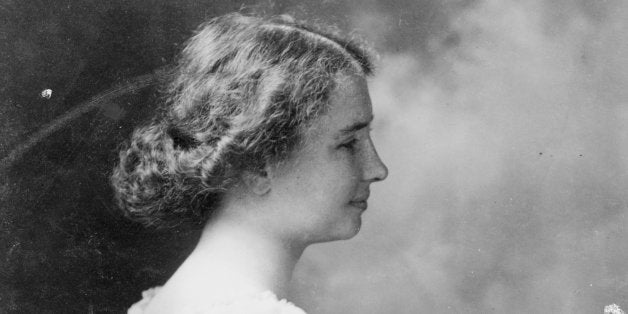
I've been fascinated by Helen Keller since I read my first slim paperback about her when I was a child, and I've read most everything about her since. I've seen the movie The Miracle Worker more times than I can count, and still feel the emotional wallop of the dining room scene: you remember the one -- a young Helen fights her new teacher Anne Sullivan tooth and nail in the Keller family dining room in Alabama, and amidst broken crockery and smashed plates Helen finally, finally succumbs to Anne's demands that she eat from a plate.
And who can forget the scene at the water pump? A young, hardscrabble-looking Helen flails about, still unaware of language, until the stellar moment when Anne forces Helen's hand under the splashing water of the pump in the yard and then. Then, suddenly, a wave of light washes across Helen's small face. "W-a-t-e-r," Anne spells rapidly into Helen's palm, and voila -- Helen stands up, alert to the world around her, because finally she knows that everything has a name.
My images of Helen Keller were, I'm a bit ashamed to admit, of a "miracle" child and a rather "saintly" young woman who cared for others and had few personal desires of her own.
So I can't tell you my surprise -- no, maybe shock -- when I picked up a new biography of Helen a few years back. I was startled to read in it a short chapter -- maybe six pages long -- that while in her thirties Helen had a love affair, became secretly engaged, and defied her teacher and family by trying to elope with the man she loved.
"What?" I put the book down and thought. "Helen Keller had a love affair?" I, like many people, had not really thought of her as a woman -- with normal romantic and carnal desires.
I shut the book and knew one thing: There was a story there. A big story. And I was on my way to writing my novel, Helen Keller In Love, where I imagine the love story Helen Keller could not -- or would not -- tell.
Soon I had taken out all the books about Helen from my local library, and delved into the Helen
Keller archives that hold a wealth of letters, newspaper articles, and photos that document Helen's life. All the while I searched for clues to this secret love affair with two questions in my mind: What was it like for Helen to be in love? And why couldn't she marry?
I quickly learned that from the time Helen was young, she preferred men to women. Even as a child, if a man came to the house Helen would ask, "Do I look pretty?"
Yet Helen's family, her teacher, and most of the society around her in 1916, felt strongly that women with disabilities should not marry or have normal romantic desires.
I was surprised to learn that when Helen was a young woman, at school in New York City and later at Radcliffe College, other girls went out with their boyfriends, while Helen studied or socialized with Anne. During that time Helen secretly read romance novels, but if Anne caught her she'd tell Helen to put the novel away and read something to improve her mind.
I was also surprised to learn of other ways Helen's family tried to keep her from having normal romantic desires: they wouldn't let her be alone with a man. One time, at Radcliffe, a handsome young man was assigned to proctor Helen's exam. Her mother had him replaced.
So Helen had desires, but couldn't fulfill them.
But she tried anyway.
The story of the romance as I tell it in Helen Keller In Love [Viking, $26.95] is set against the backdrop of Helen's fascinating life story: her vocal protests against the United States' entry into World War I, her support of the NAACP and soldiers blinded by war, and her fight for women's rights, birth control, workers' rights, and the prevention of blindness.
In 1916, when Helen was in her thirties and world-famous, her teacher and companion, Anne Sullivan, fell terribly ill. Anne's estranged husband sent Peter Fagan, a twenty-nine year old Boston Herald reporter, to be Helen's private secretary. The pair quickly became infatuated. Peter rapidly learned the manual finger-spelling language. Soon he spelled the content of letters, newspaper articles, and books into Helen's open palm. In close contact with a man for the first time in her life -- a man who shared her passion for politics, her zest for life -- Helen felt alive, awake. The couple fell in love.
Yet Helen's family, her teacher, and most of the society around her in 1916, felt strongly that women with disabilities should not marry or have normal romantic desires.
And Helen Keller was caught between loyalty to her family and her own yearnings for love.
Yet perhaps Helen Keller's real untold story is this: her triumph over multiple disabilities and her enormous celebrity had trapped her within a constricting saintliness and an image of purity. Though she could speak up about equality, the rights of others -- even, occasionally, sexuality -- she was not granted the rights she sought for others.
It turns out we didn't really know Helen Keller at all.
Isn't it time we did?